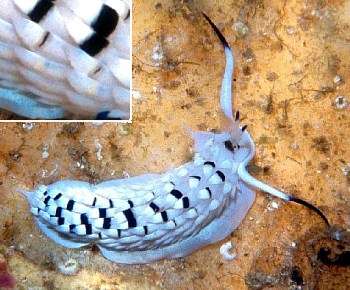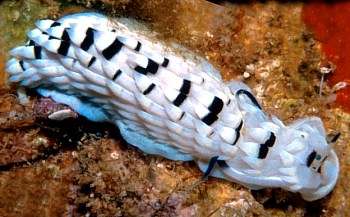

Cerberilla sp. 3.
Order: NUDIBRANCHIA
Suborder: AEOLIDINA
Family: Aeolidiidae
PHOTO
two photos of the same animal, 38mm long, and found at night crawling on the surface of the sand near the lagoon shore of Enewetak Island at a depth of about 3 meters. INSET showing pale yellow band across some cerata above black band. PHOTO: Scott Johnson.
Similar in colour to Cerberilla annulata but yellow bands only faintly visible on a few cerata.
See Scott Johnson's message below.
Authorship detailsRudman, W.B., 1999 (November 26) Cerberilla sp. 3. [In] Sea Slug Forum. Australian Museum, Sydney. Available from http://www.seaslugforum.net/find/cerbsp3
Related messages
Re: Scott's Cerberilla
December 1, 1999
From: Clay Carlson

Dear Bill,
Re Scott's Cerberilla. Here is a photo of one from Guam.
Details: 25mm; Guam, Piti Crater, 5m; 17 March 1969; Photo: Rick Chesher
Clay Carlson
Merizo, Guam
clay.carlson@kuentos.guam.net
Carlson, C. , 1999 (Dec 1) Re: Scott's Cerberilla. [Message in] Sea Slug Forum. Australian Museum, Sydney. Available from http://www.seaslugforum.net/find/1620Thanks Clay,
It looks like this species has a wide distribution at least in the Western Pacific.
Bill Rudman.
Cerberilla from the Marshall Islands
November 27, 1999
From: Scott Johnson


Hi Bill,
Glad to see the posted Cerberilla species. I've been uncertain about the identity of the single species I've so far seen in the Marshalls. Looking at your pictures, it seems closest to C. annulata, since it has black and (faint) yellow banks on the cerata. Attached are two scans of the single specimen I've run across. This animal was 38mm long and found at night crawling on the surface of the sand near the lagoon shore of Enewetak Island at a depth of about 3 meters.
I have another Cerberilla from the Solomon Islands that I'll send separately.
Scott
johnson@kmr.ll.mit.edu
Johnson, S., 1999 (Nov 27) Cerberilla from the Marshall Islands. [Message in] Sea Slug Forum. Australian Museum, Sydney. Available from http://www.seaslugforum.net/find/1614Thanks Scott,
I have seen photos of an animal from Fiji which looks just like this but no sign of yellow. It certainly looks like C. annulata but I'll err on the side of caution and leave it as Cerberilla sp 3.. I've found its easier to amalgamate 2 species in the Forum than split them up.
At 35mm, your animal's proportionally long oral tentacles, fit my suggestion that this is a feature of juvenile animals, although the pictures I am posting today of Cerberilla incola don't fit the theory, the juvenile having very short oral tentacles.
Best wishes,
Bill Rudman.
